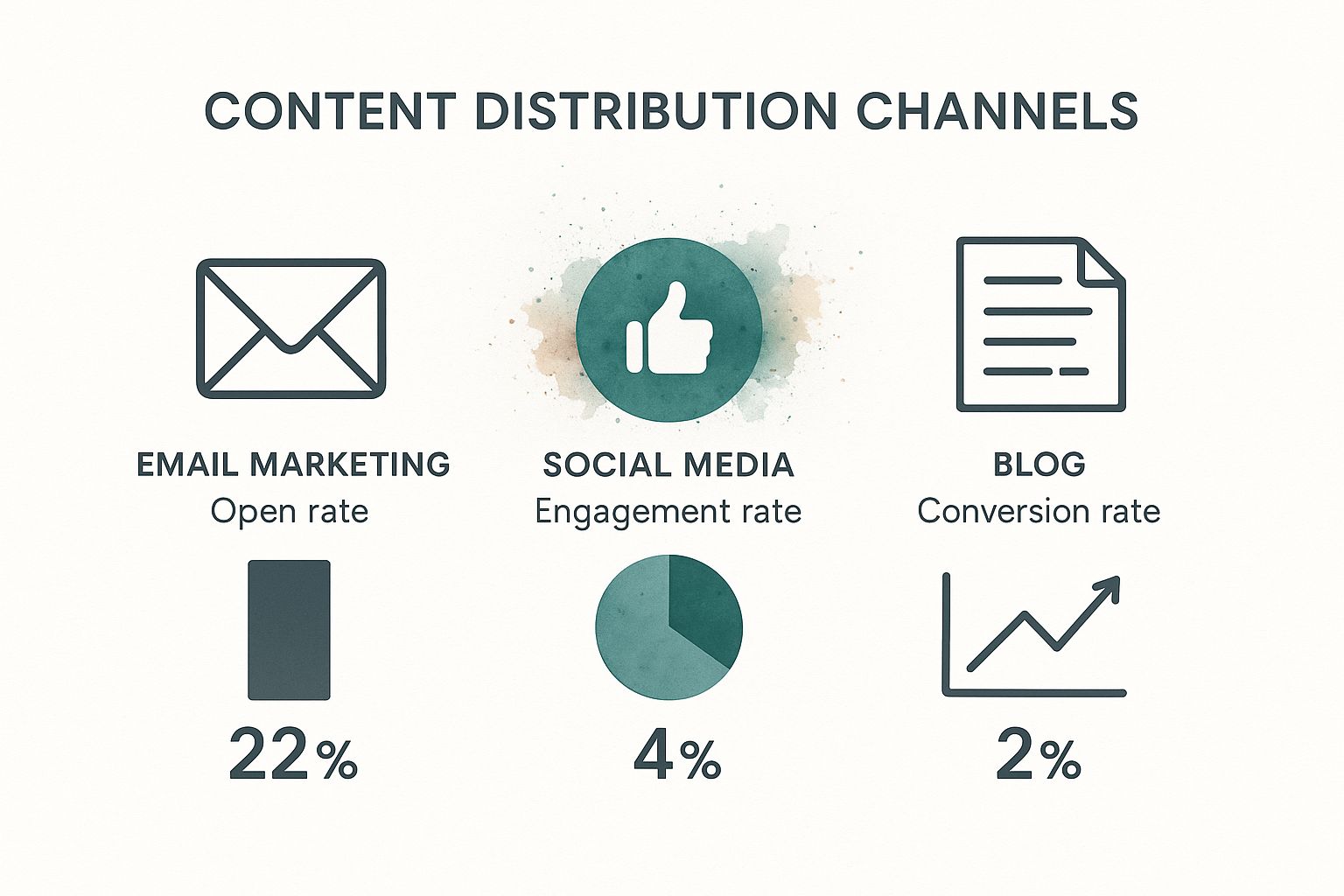Ethical & Affordable Content Marketing for Consultants
Discover ethical content marketing for consultants. This guide shares actionable, affordable strategies to build trust and attract high-value clients.

When consultants talk about content marketing, we're really talking about the art of sharing valuable expertise for free. The goal isn't to hit people with a sales pitch. It's to attract, engage, and ultimately win over ideal clients by proving you can solve their problems before they ever sign a contract. Done right, this ethical approach positions you as the only expert they'll want to call.
Building Your Ethical Marketing Foundation

So much marketing advice out there feels transactional and frankly, a little soulless. We're taking a different path. This isn't about generic tactics; it's about building a marketing engine that runs on your core values. The idea is to choose ethics and genuine value, long before you ever ask for a sale. This approach makes sure every blog post, webinar, or social media update you create feels authentic and is genuinely helpful, all while respecting your budget.
Before you get lost in the weeds of what to create, you have to nail down your "why." It all starts with a clear understanding content marketing strategy. Think of it as the blueprint for every decision you'll make. Without a solid plan, you'll just be creating noise—content that feels disconnected from your business goals and completely misses the mark with the people you’re trying to help.
Pinpoint Your Ideal Audience
The first rule of ethical marketing? Get specific. Trying to be everything to everyone is a surefire way to burn through your budget and dilute your message. Instead, zero in on the exact group of people you are uniquely positioned to serve.
Think about the clients who get the absolute most from your expertise. Who are they? What keeps them up at night?
When you focus on a tight niche audience, a few amazing things happen:
- You create deeply relevant content. Your articles and videos will feel like they're speaking directly to your audience's biggest challenges and goals.
- You build real connections. Showing you truly get their world is the fastest way to build trust.
- You use your resources wisely. No more wasting time and money marketing to people who were never going to hire you anyway. This is the cornerstone of an affordable strategy.
Set Clear and Affordable Goals
Your content goals should be a direct reflection of your values. Forget chasing vanity metrics like follower counts or viral shares. The real win is building long-term relationships that lead to sustainable growth. This mindset respects your audience's time and your own budget. An ethical strategy is also an affordable one.
And on that note, we take your privacy just as seriously. If you're curious about how we handle data and our commitment to being transparent, you can find all the details right here: https://contentide.com/privacy.
The real measure of success for a consultant isn’t just about the number of leads you generate. It's about attracting the right leads—the ones who are a perfect fit for both your services and your values. Quality of connection will always trump quantity of contacts.
This isn’t just a feel-good idea; it’s a powerful business strategy. With the content marketing industry projected to hit $107 billion by 2026, building a brand on trust will be your single greatest advantage. The data backs this up: high-performing companies are already dedicating over 10% of their marketing spend to content. They know that investing in real, ethical value is what truly pays off.
To help you put this all together, here’s a simple table outlining the key components for your own ethical and affordable content strategy.
Your Ethical Content Strategy Blueprint
This table breaks down how to build a content marketing plan rooted in ethical principles and smart, affordable tactics.
| Strategy Component | Ethical Approach | Affordable Tactic |
|---|---|---|
| Audience Targeting | Focus on a specific niche you can genuinely serve, prioritizing depth over breadth. | Create detailed client personas based on past successful projects instead of expensive market research. |
| Goal Setting | Prioritize metrics that reflect trust and relationship-building (e.g., newsletter sign-ups). | Track engagement on a simple spreadsheet. Focus on one or two key metrics to avoid overwhelming yourself. |
| Content Creation | Produce content that solves a real problem for your audience, with no strings attached. | Repurpose a single piece of core content (like a blog post) into multiple formats (social posts, video script). |
| Data & Privacy | Be transparent about data collection and give your audience control over their information. | Use privacy-friendly analytics tools and have a clear, easy-to-read privacy policy on your website. |
| Promotion & Outreach | Build genuine connections through conversation and community, not spammy mass emails. | Spend 15-20 minutes a day engaging in relevant online communities or social media conversations. |
By weaving these principles into your plan from day one, you build more than just a marketing funnel. You build a reputation.
Creating Content That Solves Real Client Problems

Your content calendar shouldn't be a chore you dread. Think of it as a living document that reflects the real-world problems your clients are trying to solve every single day.
The best content marketing for consultants is rooted in generosity and ethics. It's about sharing your expertise to build trust long before a contract is ever signed. This means your best ideas won't come from some complex, expensive keyword tool, but from the conversations you're already having.
Your content should be a direct answer to the questions that pop up during sales calls, client meetings, and even in the online industry forums where your ideal clients hang out. This approach guarantees your work is always relevant and genuinely helpful.
Uncovering Your Best Content Ideas
The secret to an endless supply of valuable topics is to become an obsessive listener. Your clients are telling you exactly what they need to know—you just have to pay attention.
Keep a running list of the questions they ask, the challenges they mention, and the goals they're struggling to reach.
Let’s say you’re a financial consultant. You might notice that three different prospects asked you about managing cash flow during seasonal slumps. That's not just a conversation; that's a perfect topic for a detailed blog post, a downloadable checklist, or a short video explaining the concept. By creating content that solves this specific issue, you're not just marketing—you're demonstrating expertise and providing immediate, ethical value.
Think about the places your clients go for answers:
- Industry Forums and Groups: What questions are being asked repeatedly in LinkedIn groups or on Reddit?
- Sales Call Objections: What hesitations or concerns come up before a client signs on? Address these proactively in your content.
- Post-Project Questions: What follow-up advice do clients always need after your work is done? This stuff is gold for creating "next step" content.
Choosing the Right Format for Your Message
Once you have an idea, the next step is picking a format that fits both the message and your budget. You don't need a high-end production studio to create impactful content. The goal is clarity and value, not Hollywood-level polish. Choosing affordable methods is part of an ethical, sustainable strategy.
Consider these powerful (and affordable) options:
- Blog Posts: Perfect for in-depth explanations and establishing yourself as a thought leader.
- Checklists or Templates: These offer a tangible, practical tool your audience can use immediately.
- Short Videos: Just use your smartphone to record quick tips or answer a common question. It’s more authentic that way, anyway.
The role of content in building brand awareness is especially powerful for us consultants. In fact, research shows that 71% of consumers look at a blog post during their customer journey, which shows how educational content directly influences their decisions. You can learn more about how content impacts purchasing decisions by reviewing these industry trends.
The most ethical and effective content marketing strategy for consultants is to simply answer the questions your ideal clients are already asking. Be the person who provides clarity in a world of noise, and you’ll become the obvious choice when they're ready to hire an expert.
Using Technology to Work Smarter, Not Harder

Let's be honest—as a consultant, your time is everything. Every minute you spend on administrative or repetitive tasks is a minute you're not spending on high-value client work. That's where technology comes in, but it's a double-edged sword.
The goal isn't just to use tech, but to use it thoughtfully. Think of it as a way to handle the grunt work so you can focus on strategy, client relationships, and the deep thinking that people actually hire you for. We’re aiming for smarter, more affordable work, not just more of it.
AI as Your Creative Assistant
The conversation around AI is loud, but it's often misunderstood. Don't think of AI as something that will write for you. Instead, picture it as a super-fast, endlessly patient brainstorming partner. An ethical use of AI is to use it to help you get started, not to finish the job.
I’ve found it’s most powerful for breaking through that initial "blank page" paralysis.
For instance, you can fire up an AI tool to:
- Generate initial outlines for a complex white paper you need to write.
- Brainstorm a dozen different headlines for a blog post you’ve already drafted.
- Summarize dense research to quickly pull out the key statistics and talking points.
This approach is becoming the new normal. We’re seeing a clear shift in the industry, with over 50% of marketing professionals now using generative AI to help draft content. It’s all about efficiency—letting the machine handle the groundwork so you can focus on strategy.
The key is to always be the final editor. AI can generate a structure, but only you can infuse it with your unique experiences, client stories, and hard-won insights. Your personal, ethical touch is what separates valuable content from generic noise.
Affordable Tools to Elevate Your Content
Beyond AI, a few select tools can give your content a truly professional feel without breaking the bank or requiring a film degree to operate. A smart, lean tech stack lets you punch well above your weight, creating assets that look just as good as those from larger firms, but at a fraction of the cost.
Here are a few categories of affordable tools I always recommend consultants explore:
- Graphic Design: Platforms like Canva are a lifesaver. You get access to thousands of templates for creating slick social media graphics, presentation slides, and document headers with a simple drag-and-drop editor.
- Headline Creation: When you're staring at a finished article and have no idea what to call it, a powerful headline generator can give you a list of engaging options optimized for clicks.
- Video Editing: You don't need expensive, complex software anymore. Simple, browser-based video editors let you trim clips, add text, and pop in some background music right from your laptop.
- Content Scheduling: Tools like Buffer or Later are non-negotiable for consistency. You can batch-schedule all your social media posts for the week in one sitting, ensuring you maintain an active presence without the daily scramble.
By picking just a few key, affordable tools, you can automate the repetitive stuff and produce polished content without the headache. This is how you build a consistent, high-quality presence that attracts the right clients.
Distributing Your Content for Maximum Impact
Look, creating a brilliant piece of content is only half the battle. Maybe not even half. If nobody ever sees it, it can't build trust, it can't start conversations, and it definitely can't attract new clients.
A mistake I see consultants make all the time is treating distribution as an afterthought. They'll spend a week writing a killer guide, then just post the link once on LinkedIn and hope for the best. That’s not a strategy; it’s a lottery ticket.
Real impact comes from a deliberate, ethical approach to getting your expertise in front of the right people. This doesn't mean you need a massive ad budget. It just requires a smart, affordable plan focused on reuse and genuine connection. Your goal is to turn one core piece of content into an army of assets working for you across multiple channels.
Repurpose Everything You Create
The single most effective and affordable way to maximize your content's impact is through repurposing. Instead of constantly being on the hamster wheel of "what's my next idea?", think of each major piece—like a detailed blog post or an in-depth guide—as a "pillar."
From that one pillar, you can build dozens of smaller, bite-sized assets.
This approach respects your time and your audience's attention. Not everyone has 20 minutes to read a 2,000-word article. But they might have two minutes for a quick video or ten seconds to glance at an infographic that hits the same key points.
From just one pillar blog post, you could easily create:
- A short video script. Just pull out the three main takeaways from your article and talk to your camera about them.
- An infographic. Use a free tool like Canva to visualize the key data points or steps from your guide. Simple and highly shareable.
- A series of social media posts. Pull out five compelling quotes or surprising statistics to share over the next week.
- A checklist. Turn the actionable steps into a downloadable PDF you can offer to your email subscribers as a bonus.
This isn't about creating more work. It’s about getting the most possible value out of the hard work you've already done. It's the most affordable strategy there is.
Build Relationships with Email
While social media is great for getting your name out there, email marketing is where you build deep, lasting relationships in an ethical way.
Think about it: your email list is one of the only marketing channels you truly own. It’s a direct line to people who have explicitly raised their hand and said, "Yes, I want to hear from you." You're not at the mercy of some algorithm that could change overnight.
Don't just use your email list to blast out links. Treat it like a private conversation with your most promising prospects. Share your latest content, sure, but also offer exclusive insights you haven't shared elsewhere. Ask them questions. Tell a story about a recent client win (or even a failure).
This is how you go from being just another consultant in their inbox to becoming their trusted advisor.
The goal of content distribution isn't just to get clicks; it's to start conversations. Every piece of content you share should be an invitation for your ideal clients to engage, ask questions, and see the value you bring to the table.
Be Strategic and Consistent
Effective distribution is really just a good habit. You don't need a complicated system. Just create a simple promotion checklist for every new piece of pillar content you publish.
What does that look like? Share it on your primary social channel (like LinkedIn). Send it to your email list with a personal note. Then, identify one or two smaller assets you can repurpose from it over the next week. That’s it.
By building a simple, repeatable system, you ensure your valuable expertise consistently reaches the audience it’s meant to serve. This steady, consistent, and affordable effort is what turns great content into a reliable engine for attracting your ideal consulting clients.
Measuring What Truly Matters for Your Business
It’s easy to get a little dopamine hit from likes, shares, and a rising follower count. But let's be real: do those numbers actually pay the bills? For a consultant, the game isn't about applause; it's about attracting the right clients.
This is where you have to cut through the noise and focus on the metrics that directly impact your bottom line. We're talking about building an ethical and affordable marketing engine that generates real business, not just online validation.
Vanity metrics feel good, but they're often a distraction. They don't tell you if your content is actually connecting with a potential client. Meaningful metrics, on the other hand, track the actions that lead directly to new business. These are the numbers that prove your content is actually working for you.
To get this right, you'll need to spend a little time understanding content marketing analytics. It's not as scary as it sounds, and this knowledge is what helps you make smart, affordable decisions with your limited time and resources.
Ditching Vanity for Value
The first big mental shift is moving from measuring broad awareness to tracking specific actions. Stop asking, "How many people saw my content?" and start asking, "How many of the right people took the next step?"
Your goal is to measure intent, not just attention.
This is where free and powerful tools like Google Analytics become your best friend. You don't need a massive software budget to see which blog posts are driving qualified traffic or which topics are leading people straight to your "Contact Us" page. This data removes the guesswork. It lets you double down on what works and kill what doesn’t.
Just look at how different channels perform on some key metrics.

This quick comparison shows why a blended strategy is so critical. Each channel plays a different role in nurturing someone from a curious reader into a paying client.
The most ethical way to measure your content is to focus on metrics that reflect genuine interest and trust. A single qualified consultation request from a thoughtful blog post is infinitely more valuable than a hundred likes from an unengaged audience.
Tracking the Metrics That Count
Okay, so what should you actually be tracking? Focus on the KPIs that directly connect your content to your consulting pipeline. These are the numbers that tell a clear story about your business growth.
- Qualified Consultation Requests: How many people filled out your contact form after reading a specific article? You can track this by creating a unique "thank you" page for that form and setting it up as a goal in your analytics. It's a direct line from content to lead.
- Content-Driven Client Conversions: This one is simple but powerful. When a new client signs on, just ask them how they found you. Keep a simple log of which content pieces get mentioned. This helps you attribute real revenue back to your efforts.
- Email Subscriber Growth: This is a fantastic leading indicator. Someone who trusts you enough to hand over their email address is one of your warmest leads.
- Time on Page for Key Articles: Are visitors spending several minutes reading your in-depth guides? That signals deep engagement and tells you the content is hitting the mark.
To make this crystal clear, I've put together a simple table that separates the metrics that feel good from the ones that actually build your business.
Key Metrics for Consultant Content Marketing
| Metric Category | Vanity Metric (Avoid Over-Focusing) | Meaningful Metric (Focus On This) |
|---|---|---|
| Lead Generation | Social Media Follower Count | Qualified Consultation Requests |
| Audience Building | Page Views | New Email Subscribers |
| Engagement | Likes & Shares | Time on Page / Scroll Depth |
| Business Impact | Website Traffic | Content-Attributed Revenue |
By zeroing in on these meaningful outcomes, your content stops being a "cost" and starts becoming a predictable, reliable, and affordable engine for growing your consulting practice.
Common Questions About Content Marketing for Consultants
Jumping into content marketing always kicks up a lot of questions. As a consultant, your time is gold, and every marketing move has to be practical and affordable. Let's tackle the most common concerns I hear, with straightforward, ethical answers to help you build a strategy that works for you, not against you.
The biggest question is almost always about time. How much is really needed without eating into billable hours?
The answer is simpler than you'd think: consistency crushes intensity. It’s way better to dedicate a focused 90 minutes a week, every single week, than it is to try and cram in a massive eight-hour content day once a month. That’s just a recipe for burnout.
Start small. Seriously. Block out a non-negotiable window in your calendar. Use that time to write one thoughtful LinkedIn post, record a quick two-minute video answering a client question, or just outline a single blog post. The goal is to build a sustainable, affordable habit, not to become a full-time publisher overnight.
Where Should I Publish My Content?
Next up, consultants wonder where their content will actually make a difference. With a million platforms out there, it's easy to feel stretched thin. The key is to pick one primary channel and truly master it before you even think about expanding.
For most consultants, LinkedIn is the place to be. It's where your professional network, potential clients, and industry peers are already hanging out. Focus all your energy on sharing valuable insights there consistently. Once you’ve got a good rhythm going, you can think about starting an email newsletter to build a more direct line to your most engaged followers.
Remember, the goal isn't to be everywhere. It's to be where your ideal clients are, delivering real value. A good, ethical strategy means respecting your audience's attention by showing up in the right place with the right message, not just shouting into the void.
How Long Until I See Results?
This is probably the hardest part for driven consultants: patience. Content marketing is a long game, not a quick fix. You're building a reputation and earning trust, and that just doesn't happen overnight.
While you might see some likes and comments early on, tangible results like qualified leads often take three to six months of consistent, focused effort.
Think of it like planting a tree. You won't get any shade the day after you plant the seed, but with steady care, it grows into a massive asset. While your content is working its magic in the background, keep up with your more direct outreach to keep the pipeline full.
For a deeper dive into other common questions, you can always check out our full content marketing FAQ page for consultants to get the clarity you need.
Ready to stop staring at a blank page and start publishing content that actually attracts clients? Contentide is an AI-powered content generator I designed to help busy consultants create authentic, high-performing LinkedIn posts in minutes. Turn your expertise into engaging content and build your professional brand with an affordable and ethical tool. Get started for free today at https://contentide.com.
Hope you found this helpful. Feel free to share your thoughts.